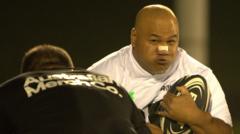The thrill of collision sports has entered a new realm with the introduction of the 'Run It Championship League,' a backyard-style game that is rapidly gaining international attention. This game, which started in Australian and New Zealand playgrounds, sees competitors clash head-on without protective gear, igniting a controversial debate over its safety and implications on youth culture.
With players aiming to demonstrate dominance within a single tackle, the league claims to have garnered millions of views across social media. It's been described as potentially the “world’s fiercest collision sport,” one that has evolved through Pacific Islander communities and is now seeking global recognition. Following successful events in Melbourne and Auckland, the league is set for a futuristic clash in Dubai, offering a lucrative cash prize of A$200,000 for its winners.
However, the excitement surrounding Run It is shadowed by the growing concerns voiced by medical professionals, sporting experts, and even family members of those injured while playing. Emphasizing the inherent risks associated with head-on collisions, critics argue that the game lacks the necessary safety protocols to truly protect participants. Instances of serious injuries, including the tragic death of a teenager in New Zealand after attempting a tackling maneuver, have sparked outrage and calls for stricter regulations.
The league’s founders insist they have safety measures in place, which include thorough medical examinations before competitors are allowed to participate. Yet, experts remain skeptical, stating that the risks of concussions and long-term brain injuries are inevitable in a sport that encourages aggressive physical contact.
While the financial backing and commercial interests behind the league grow, mental health workers like Shenei Panaia caution about the message it may convey to young men. They argue that the culture surrounding the sport risks perpetuating ideas of masculinity that measure worth through physical toughness and pain endurance.
In the face of criticism, Run It is undeterred, drawing parallels to traditional sports like rugby that also embrace physicality. Their aim is to establish a reputable presence in the competitive sports landscape while maintaining their vision of a game steeped in tradition and skill.
Amidst the fervor and excitement surrounding the league, questions remain about its sustainability and the responsibilities of organizers in prioritizing player safety. As the debate progresses, while the league revels in its rising popularity, its future hinges on the balance between thrilling entertainment and responsible sportsmanship.




















